
Eureka is a side-wheel paddle steamboat, built in 1890, which is now preserved at the San Francisco Maritime National Historical Park in San Francisco, California. Originally named Ukiah to commemorate the railway's recent extension into the City of Ukiah, the boat was built by the San Francisco and North Pacific Railroad Company at their Tiburon yard. Eureka has been designated a National Historic Landmark and was listed in the National Register of Historic Places on April 24, 1973.

The St. Clair Tunnel is the name for two separate rail tunnels which were built under the St. Clair River between Sarnia, Ontario and Port Huron, Michigan. It was the first full-size subaqueous tunnel built in North America. It is a National Historic Landmark of the United States, and has been designated a civil engineering landmark by both US and Canadian engineering bodies.
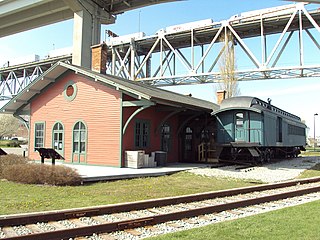
The Grand Trunk Western Railroad Depot is a former railway depot located at 520 State Street in Port Huron, Michigan. It has been converted into a museum. The building was listed on the National Register of Historic Places in 1977.
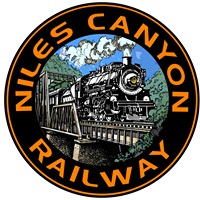
The Niles Canyon Railway (NCRy) is a heritage railway running through Niles Canyon, between Sunol and the Niles district of Fremont in the East Bay of the San Francisco Bay Area, in California, United States. The railway is listed on the National Register of Historic Places as the Niles Canyon Transcontinental Railroad Historic District. The railroad is operated and maintained by the Pacific Locomotive Association which preserves, restores and operates historic railroad equipment. The NCRy features public excursions with both steam and diesel locomotives along a well-preserved portion of the First Transcontinental Railroad. The Golden Gate Railroad Museum moved its collection from San Francisco to the NCRy in 2007 for storage and limited operations after their home at Hunters Point Naval Shipyard was shut down for redevelopment.

The Grand Trunk Milwaukee Car Ferry Company was the Grand Trunk Western Railroad's subsidiary company operating its Lake Michigan railroad car ferry operations between Muskegon, Michigan, and Milwaukee, Wisconsin, from 1905 to 1978. Major railroad companies in Michigan used rail ferry vessels to transport rail cars across Lake Michigan from Michigan's western shore to eastern Wisconsin to avoid rail traffic congestion in Chicago.

The Pere Marquette 1223 is a steam locomotive on permanent display in Grand Haven, Michigan. She is one of two surviving Pere Marquette 2-8-4 (Berkshire) engines. No parts from 1223 were used to restore sister engine 1225 to operating condition, due to the objections of the Michigan Railroad Club, then unofficial custodians of the engine. The MSU Railroad Club did hold some successful fundraising events at the 1223 during the State Fair. That money was used in the restoration of the 1225.

Longworth Hall is a registered historic building in Cincinnati, Ohio, listed in the National Register on December 29, 1986. Constructed by the Baltimore and Ohio Railroad in 1904 as the B & O Freight Terminal, the building was reported to be the largest structure of its type in the world at 5 stories high and 1,277 feet (389 m) long. Camden Yards in Baltimore is a similar structure.
The Toledo, Saginaw and Muskegon Railway is a defunct railroad incorporated in January, 1886. The railroad offered service between Ashley, Michigan and Muskegon, Michigan starting on August 1, 1888. The Grand Trunk Railway of Canada took control the same day, but the company did not merge with the Grand Trunk Western Railway until 1928.
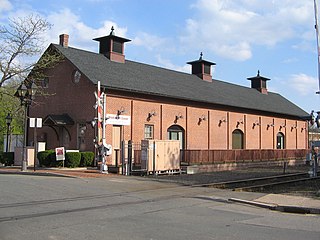
The Hartford & New Haven Railroad Freight Depot is a historic building at 40 Mechanic Street in downtown Windsor, Connecticut, across the street from the equally historic Hartford & New Haven Railroad Depot. Built about 1870, it is a well-preserved example of a Gothic Revival freight depot. It was listed on the National Register of Historic Places in 1988. It is now the home of the Windsor Arts Center, a non-profit place that exhibits the work of visual and performing artists.

Grand Rapids, Grand Haven and Muskegon Railway Depot is a historic railway station for the Grand Rapids, Grand Haven and Muskegon Railway in Coopersville, Michigan. The Coopersville Area Historical Society and Museum is now housed in the station.

The Beaumont St. Louis and San Francisco Railroad Water Tank is a railroad water tank constructed in 1875, in Beaumont, Kansas. It served the St. Louis, Wichita & Western Railway, and was used to refill the boilers of steam locomotives on that line. It was added to the National Register of Historic Places in 1993.
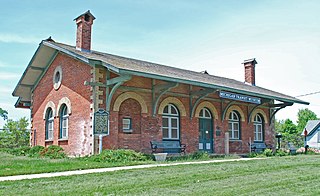
Mount Clemens station is a historic railroad depot located at 198 Grand Street in Mt. Clemens, Michigan. Young Thomas Edison learned telegraphy at this station. The building was listed on the National Register of Historic Places in 1981 as the Grand Trunk Western Railroad, Mount Clemens Station and designated a Michigan State Historic Site in 1973. It is now operated as the Michigan Transit Museum.

Ashley Planes was a historic freight cable railroad situated along three separately powered inclined plane sections located between Ashley, Pennsylvania at the foot, and via the Solomon cutting the yard in Mountain Top over 1,000 feet (300 m) above and initially built between 1837-38 by Lehigh Coal & Navigation Company's subsidiary Lehigh and Susquehanna Railroad (LH&S). One result of the 1837 updates of omnibus transportation bills called the Main Line of Public Works (1824), the legislation was undertaken with an eye to enhance and better connect eastern settlement's business interests with newer mid-western territories rapidly undergoing population explosions in the Pre-Civil War era. But those manufactories needed a source of heat, and the Northern Pennsylvania Coal Region was barely connected to eastern markets except by pack mule, or only through long and arduous routes down the Susquehanna then overland to Philadelphia.

The Fremont, Elkhorn & Missouri Valley Railroad Passenger Depot, also known as the Chicago and North Western Railway Passenger Depot and presently as the Douglas Railroad Interpretive Center, was built in 1886 in Douglas, Wyoming to accommodate traffic on the Fremont, Elkhorn and Missouri Valley Railroad's (FE&MV) terminus at the newly built town. The depot was built as a fairly small, cautious investment in a possibly ephemeral frontier town. Immediately following the completion of the depot Douglas saw an epidemic of typhoid fever and the worst winter in a generation, and the railroad decided to push on to Casper for its terminus. The town's population declined from 1600 in 1886 to 900 in 1888. By 1891 Owen Wister reported that Douglas had a population of about 350. However, by 1910 Douglas had 2246 residents and hosted the Wyoming State Fair. The presence of the fair stimulated rail traffic, while the FE&MV merged with the Cheyenne and Northern Railway in 1903. In 1905 oil development started. In the 1950s coal mining began for the Dave Johnson Power Plant and the railway expanded its Douglas facilities to accommodate the traffic, closing the original depot and building a larger facility. The depot was acquired from the railroad's successor, the Chicago and North Western Railway, by the city in 1990.

The Union Depot is a railway station located at 610 Western Avenue in Muskegon, Michigan. It was listed on the National Register of Historic Places in 2000. It is now the Muskegon County Convention & Visitor's Bureau.

The Piers and Revetments at Grand Haven, Michigan are navigational structures located at the mouth of the Grand River in Grand Haven, Michigan. The structures were listed on the National Register of Historic Places in 1995.
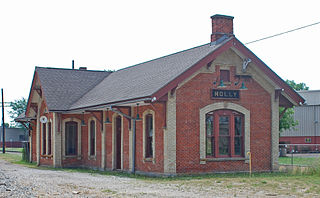
The Holly Union Depot is a former train station located at 223 South Broad Street in Holly, Michigan. It was listed on the National Register of Historic Places in 2000. It sits at the junction of tracks which are now owned by CSX Transportation and Canadian National Railway.






















